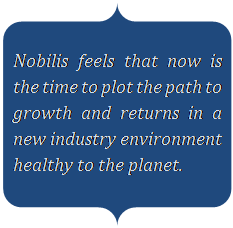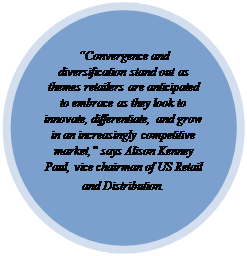
Rapid change dominates the health care landscape, but for organizations willing to take on challenges and leverage disruptive trends, the Outlook for 2017 and beyond is positive. Despite their considerable size and resources, world life science companies operate in a dynamic environment that presents numerous challenges to revenue and market share growth. There are six potential issues for 2017: Market reconfiguration and consolidation; pricing pressures; health reform and the shift to value; R&D productivity; disruptive technologies; as well as risk, regulations, and compliance will tend to shape the life sciences and health care industry in the coming year and beyond.
Nobilis Global, consulting to life science companies, operates in a dynamic environment that presents numerous opportunities for growth. To capture these opportunities Nobilis Global is concentrated on areas with each individual entity in which they excel, improving areas that are important to achieving their goals, and letting go of elements that might be holding then back.
Market reconfiguration and consolidation are driving companies to search for the right scale. This could mean narrowing to a core set of capabilities or therapeutic areas or building them out by acquiring and managing a large portfolio of businesses. Each approach is resulting in an unprecedented level of deal-making in the form of mergers, acquisitions, joint ventures, divestitures, factoring, debt consolidation and licensing agreements.1 In addition, emerging markets are fueling the growth of local companies that are expected to shift the U.S. centric “skew” of the global competitive landscape and open up new Mergers & Acquisitions (M&A) opportunities.
Innovating in specialty (versus primary care) therapeutic areas may drive considerable pharmaceutical revenue growth in coming years, however the alternative market continues to steady growth alongside traditional methodologies. Meanwhile, some biotech companies are moving to M&A and opening innovation models as a way to help overcome organic productivity challenges and spur product and market growth. A number of medtech companies are integrating R&D, marketing, engineering, and other disciplines to more effectively connect customer insights with the biodesign process. In addition, Nobilis Global as well as others, is looking for ways to wrap health care services (e.g., cellular therapy, anti-aging, photon light therapy, stem cell therapy, electromagnetic therapies, nanotechnology, etc.) around their products.
“As the health care industry shifts and transforms so, too, must the life sciences sector. In 2017, this will require companies to recalibrate business models and research priorities, as well as retool commercial practices to better articulate their value proposition.”
In addition to this idea, Nobilis Global expects to use real-world evidence to demonstrate a product’s clinical, safety, and economic impact (e.g., comparative effectiveness), and robust data analytics to improve marketing strategies and effectiveness. Nobilis Global will consider M&A transactions to scale up within particular areas of specialization and exit others, and expand into new markets as well as engage in more proactive risk management and regulatory compliance.
In another key focus area, Nobilis Global will improve R&D efficiency, diversify risks and costs and use their human capital better by employing open innovation and other novel development approaches – for example, hosting companies on site or establishing innovation centers that incubate 30-40 companies to broaden future possibilities. In pursuit of innovative new products, Nobilis Global will look to develop patient-centric suites/portfolios of products and services to improve the overall health of their customers. For example, there is growing interest in wearable technologies and sensors to monitor vital signs; digital medicines such as ingestible smart pills with microchips; and novel drug delivery systems using electromagnetic and scalar technologies, not counting the miracles stem cell technology will bring to mankind.
Nobilis Global sees “big data” becoming an integral part of life sciences organizations encompassing the entire value chain. Regulatory compliance and patient safety will become board room topics. Nobilis Global will look to other industries and non-traditional players for disruptive technologies that could be applied to health care and foster product innovation, market expansion, and revenue growth. For example, its innovative Lymph Infrared Photon Emitting (LIPHE) Machine, a lymph detoxification instrument, is expected to be a valuable partner in health care’s shift towards a patient-centered, value-based delivery model. LIPHE has the potential to improve workplace efficiencies and increasing revenue for doctors of all practices, increase patient safety with its non- invasive photon technology, better coordinate care, facilitate payments, and engage patients to take charge of their health with a holistic methodology.
In an era of specialty pharmaceuticals, Nobilis Global stands to evaluate their role with regard to social responsibility and considers the overall impact of their corporation’s reputation.
Finally, given the level of transformation occurring in the overall health care industry, Nobilis Global as a life science company pro-actively addresses many aspects of their strategy in order to maximize opportunities for their success.
Growth in the life sciences sector — comprised of the pharmaceutical, biotechnology, and medical technology (medtech) segments — is closely tied to economic and demographic drivers that fuel a continual transformation of the broader health care industry. Life sciences companies have demonstrated their ability to survive and thrive amidst recent periods of economic recession, health care spending cutbacks, geographic market swings, and changing population profiles. If history is any indication, 2017-18 will again test the sector’s ability to adapt in an era of transformation, Nobilis Global stands ready for the challenge.
 MEDIA
MEDIA
The second area of interest for Nobilis Global is Media which needs to be ready for new economic models coming their way, as demand for content anywhere and anytime accelerates. Gerald Belson, vice chairman and U.S. Media & Entertainment leader at Deloitte Consulting, LLP, shares his perspectives on growth opportunities and emerging trends. “In last year’s outlook, we stressed that the media and entertainment sector is in a rare moment where existing business models continue to thrive at the same time that new models are emerging. The traditional model still dominates, but movement to an online “over the top” (OTT) model is hastening.”
The acceleration is being driven by the rapidly growing amount of content available via the Internet and the proliferation of devices such as tablets and smart phones offering high quality viewing experiences. The growth reflects the public’s mounting appetite for content, especially video, anywhere, anytime and on any device. The world of consumers, particularly younger generations, sitting in their living rooms to watch television shows at programmed times is quickly giving way to a market of viewers using multiple devices inside and outside the home to consume content, and at the time and sequence they choose to watch.
The changing dynamic poses challenges but also offers lucrative opportunities. On the challenge side of the equation, pay TV subscription and advertising models don’t translate directly into the new online reality, and have less of a hold on younger generations. Millennials, for example, have grown up less dependent on paid television and are less likely than other demographic groups to subscribe to TV when they move out and establish their own households1.
This provides a major opportunity for entertainment content companies: The Internet channel offers the possibility for these companies to connect with and market directly to consumers. Although cable distributors will continue to play the major role in the foreseeable future, initial moves by content companies to offer individual channels and packages online represents incredible potential, especially with Millennials.
A similar dynamic is playing out in education. Access to branded, high quality content is no longer bound by classrooms. It is being distributed globally by a new set of distribution methods which allows for much more scalable reach challenging traditional educational payment and delivery models. As the media industry transforms, Nobilis Global intends to focus on new opportunities—but not at the expense of their current models. Media businesses must balance cutting off existing revenue by getting too far ahead of the curve while, at the same time, not falling so far behind that they forfeit their leadership positions.
To strike the best balance, Nobilis Global will focus on the changing economics coming their way. Advertising metrics are a prime example. These need to move beyond measuring the number of viewers and audience share in a particular time slot. Nobilis Global understands and captures the relevance and significance of changing viewing habits. Intensity of viewing attention, for example, becomes a meaningful factor in understanding advertising effectiveness, but it is extremely difficult to measure, particularly in the traditional TV viewing world.
![]()

The industry’s transformation will demand new business models that have yet to fully emerge. Mobile advertising, for example, is still evolving. But the prospect of combining viewing habits with social media, location-based services, and other technologies is opening new vistas for media targeting. Advertising messages in the online world will have the opportunity to be as individualized as the advertiser wants them to be. Nobilis Global views this as an opportunity to educate the public and then allow them to buy based on that education and discovery by launching a social responsibility based alternative and preventive health channel, a network poised to educate the public on the preventive aspects of their health and then sell the product that fulfills that need for the best price available. Utilizing online stores as well as a channel devoted to wellness, mind, body and spirit, Nobilis Global plans to target that niche market of health and beauty, strengthening its own technologies and products through continuous sale and promotion with media giants such as Time Warner-Comcast and others. Content will be the driving force, not the forced sale that is a compulsive buy.
The biggest “next thing,” however, may well arise from the merging of technology, media and telecom industries with the hyper connectivity inherent in the Internet. The borders of these industries is steadily blurring as each is increasingly able to generate and analyze eye-opening amounts of individual consumer data. Media viewing habits may become only a small part of the data set that advertisers use, and Nobilis Global is poised to utilize all aspects of social media, network media, as well as the new emerging science of holographic media.The convergence will also drive an escalating battle for control of customer relationships. Device manufacturers, telecommunication companies, media distributers, content providers, and even app developers are seeking direct relationships with customers, and Nobilis Global will be capable of wielding a strong influence because of the position it is planning to hold in these areas.

Weakening prices and a sluggish outlook for demand growth have turned investors away from the mining sector. The S&P/TSX Global Mining Index fell by about 10 percent through the end of November 2014, while the S&P 500 rose by 11 percent. Then in 2016-17, it again surged up and down driven by world economics. Given these market conditions, investors question the sector’s ability to address a decade-long productivity decline, improve capital efficiency, revive sinking shareholder returns, and service mounting debt and interest obligations.
BAIN & CO. :
"From the peaks to the depths and back again: such has been the course traced by the global diamond market since 2008. In 2013, however, the diamond market showed clear signs that its rollercoaster trajectory of recent years has moderated, and that it would be on a path of steady, sustainable growth across every step of the value chain going forward.
In 2016, rough-diamond sales increased by 2%, even though four out of five major producers increased their revenues by 5–16%. According to Kimberley Process statistics, smaller producers reduced their output, which pulled down the aggregate sales total for the year. The cutting and polishing segment of the diamond value chain reported a 4% rise in revenues, to about $22 billion. India’s share of those revenues increased at an even more robust rate, to more than 60%, confirming the country’s status as the center of the cutting and polishing industry. China, for its part, solidified its position as the hub of diamond jewelry manufacturing, capturing most of the industry’s revenue growth. China, already the global leader in overall jewelry production, now claims a growing share of global diamond-jewelry manufacturing, while the shares of Europe and the US have continued to dwindle, as manufacturers there focus almost exclusively on pieces for the top end of the market.
Retail sales of diamond jewelry rose an estimated 3%, and Euromonitor, an emerging source for perspectives on diamond jewelry sales, confirmed an even more aggressive growth trend in the first half of 2018. Continued strong demand from China and a resurgence of demand in the US powered the rise of the retail segment. In both countries retail sales grew, in percentage terms, at a high-single-digit rate."
“Full year gold demand totaled 3,923.7 tons in 2016 (from 4,087.6t in 2013). The 4% year-on-year drop was unsurprising as consumer demand was never likely to match the previous year’s record surge. Total annual supply was virtually unmoved at 4,278.2t. Growth in mine supply was balanced by a decline in recycling volumes to a seven-year low.
Waiting for a market upswing or adopting traditional cost containment measures will not likely suffice to turn the sector around. Mining companies should consider pursuing innovation for sustainable cost reduction and margin improvement, embracing autonomous mining solutions by working closely with vendors. It is Nobilis Global’leveraging data analytics to increase productivity that instills its vision into its investments. With this perspective, Nobilis Global will continue to add contracts into its portfolio for what it feels will be the commodities of the future.

The energy industry transformation is no longer “pending,” it’s underway. And the good news is that opportunities for the future are starting to come into world attention. Many of the moving pieces around fuel prices, renewables, customer interaction, managing distributed generation, electricity storage, demand response, and energy efficiency are beginning to fall into place — and we now see utilities taking concrete, financially sound steps to incorporate these elements directly into their business models to seize opportunities for growth.
While a few forward-looking utilities are well down this path, until recently the single-mindedness of the majority has been largely on defensive strategies including strengthening company balance sheets through cost reduction and leveraging traditional merger and acquisition synergies, while monitoring the playing field and assessing the risks of deploying new technologies and business models. The regulated piece of the business provides a very solid foundation to defend and build on; however, now is the time to both augment and complement that solid foundation with new and emerging technologies and business models.
Nobilis Global sees evidence that renewable energy, deregulated customer services, and energy efficiency are all entering the maturity phase and providing solid financial results for companies.
Looking at renewable energy, wind and solar power have been around for decades. But Nobilis Global understands what the ACORE President and Chief Executive Officer Michael Brower says, that “financiers now see renewables as an asset class understood by all, and utilities are commonly using them to hedge fossil fuel risk and provide scalable, low-cost, and distributed power. About 27% of new US electricity capacity added since 2007 came from wind power, now ranked among the least expensive sources of new utility-scale generation. In the case of solar power, major banks are vying to finance projects and portfolios, especially as the volume of distributed solar installations grow.”
The retail energy marketplace is also maturing. For example, Houston-based Direct Energy, acquired by UK-based Centrica plc in 2000 for about $600 million, has grown into the largest competitive retail electricity, natural gas, and energy services provider in the United States, with 2016 revenue of $11.4 billion, operating profit of $436 million, and approximately six million customer accounts across North America. The company focuses on providing residential and business customers with not just a competitive energy plan, but also with insight into their energy consumption and the tools to control it.

The evolution of the regulatory construct that is beginning to emerge in New York and other states will likely bring about profound change and could potentially better enable companies to chart new paths to profitability and success as “utilities of the future.” States like Hawaii and California are on the front edge of industry disruption due to factors like high electricity prices, abundant renewable resources, and new market entrants. But the Northeast is not far behind. New York’s “Reforming the Energy Vision” plan to overhaul its utility regulatory system and is the most comprehensive response yet. The plan brings utilities, regulators, government agencies, financiers, and innovators together to achieve system-wide efficiency, reliability, resiliency, fuel diversity, affordability, carbon reduction, and most importantly, increased customer choice and value. Other states, like Massachusetts, Georgia, North Carolina, and Minnesota, are experimenting with their own regulatory changes and more are likely to jump onboard.
The business and regulatory models mentioned here are quite progressive; however, Nobilis Global looks to enter the market with a whole new revenue model and methodology that dovetails into its real estate projects to change the course of investing. The principals of Nobilis Global have combined 10 plus years of experience in real estate finance and procurement. Nobilis Global focus is to expand into consolidating large tracts of property for development. This focus includes the development of a new commercial structure using non-traditional cost-effective electricity producing technology contributing directly to the commercial property revenue. Nobilis Global feels that now is the time to plot the path to growth and returns in this new industry environment. It plans to create an alternative to the progressive methods above that is even more financially rewarding. This cross branding will take place between its technology resources and a new plan for energy conservation that will change the energy paradigm as we know it.

The proliferation of digital, social, and mobile technologies coupled with increasing consumer adoption of these technologies, continues to change the way consumers shop. Deloitt revealed in their 2014 -2017 holiday survey that “while consumers prefer the in-store shopping experience over online, nearly three-fourths (74%) of respondents intend to do some form of online research prior to making in-store purchases.” Therefore, to capture these consumers at the start of their shopping journey, retailers must ensure that they have an appealing presence across all platforms apart from merely providing an engaging in-store experience.
Realize, however, having a presence across each platform is no longer enough, and presence is now purely table stakes. Providing a blended online and in-store experience–leaving the consumer with the feeling that they just embarked on one cohesive shopping journey as opposed to several disjointed multi-platform shopping experiences–is a growth opportunity for retailers in the coming years. This convergent holistic experience needs to encompass not only product assortment, pricing, shipping, return options, and promotional offerings, but also provide a consistent aesthetic look and emotional feel, something to experience that they cannot achieve on line.
Nobilis Global realizes that retailers that will move ahead of the pack in the coming years are those that can deliver a consistent, clear, clean, simplified, and seamless message across all channels, and be highly creative.
Additionally, effective and relevant data mining also remains a growth opportunity for retailers. The retailers that stand to gain will be those that can effectively sort through the vast amount of available data, and then zero in on the nuggets of information that can be used to enhance customer service.
 With data comes risk. Given the numerous high-profile retailer security breaches this past year, minimizing cyber risk is a business priority for retailers. Moreover, data risk management should be an enterprise-wide concern–not just an activity relegated to and housed in the IT department. Furthermore, retailers need to be cognizant of the fact that personal data security is top of mind with consumers. Not only do consumers have a heightened concern regarding the security surrounding the personal data they provide to retailers, this perceived risk is influencing their retail store patronage decisions. As evidence, a 2014-16 holiday survey revealed that 20 percent of consumers indicate they will not shop at a retailer that has experienced a data breach. However, a silver lining in this gray cloud is that 36 percent of consumers indicate they are more likely to shop at a retailer that provides education pertaining to the security of their personal data. Consequently, wise retailers will be forthcoming and transparent with information regarding how they are using and securing consumers’ personal information. With this in mind, Nobilis Global has both a software and hardware driven non-hackable technology to introduce to retail, business, entertainment, and government security in this coming year.
With data comes risk. Given the numerous high-profile retailer security breaches this past year, minimizing cyber risk is a business priority for retailers. Moreover, data risk management should be an enterprise-wide concern–not just an activity relegated to and housed in the IT department. Furthermore, retailers need to be cognizant of the fact that personal data security is top of mind with consumers. Not only do consumers have a heightened concern regarding the security surrounding the personal data they provide to retailers, this perceived risk is influencing their retail store patronage decisions. As evidence, a 2014-16 holiday survey revealed that 20 percent of consumers indicate they will not shop at a retailer that has experienced a data breach. However, a silver lining in this gray cloud is that 36 percent of consumers indicate they are more likely to shop at a retailer that provides education pertaining to the security of their personal data. Consequently, wise retailers will be forthcoming and transparent with information regarding how they are using and securing consumers’ personal information. With this in mind, Nobilis Global has both a software and hardware driven non-hackable technology to introduce to retail, business, entertainment, and government security in this coming year.
Data security is not the only activity that should be integrated across functions. Retailers planning to thrive in the coming year need to shift their organizational and cultural mindset from a functional expertise and departmental silo focus, to a more collaborative, cross-functional, and holistic approach.
“What got you to where you are, won’t get you to where you want to go.” Nobilis Global realizes that success is dependent on constant innovation–to be relevant and grow, embrace disruption and evolve. The most compelling example is the changing role of the brick and mortar store location and accompanying square footage. Being in an ‘A’ location doesn’t buy the competitive advantage it did in the past. This decreased importance of the physical store location and space also leads to lower barriers for entry. With these lower barriers comes increased competition from local, regional, global, and purely online retailers. Competition is just a click away. In terms of what factors are currently important, price and additional free services, such as shipping and returns, are increasingly guiding consumer shopping decisions. Retailers must be nimble in responding to competitive pricing actions–as consumers continue to incorporate price checking into their shopping process–both prior to and during the in-store visit.
Finally, as the competition heats up and consumers continue to seek bargains, success will come to those who are creative in managing their product supply chain–ensuring consistent supply, services, and quality across all channel platforms. Nobilis Global feels the importance of adopting an agile supply chain strategy is of critical importance for allowing retailers to preserve already narrow margins while simultaneously not compromising the customer experience.
To grow and differentiate, retailers need to look beyond traditional formats, products, and services. Industry convergence is expected to continue to increase in the coming year. We have already seen many examples of convergence: retailers providing health care services; physical stores matching the online experience through increased in-store technology; and online sites providing a virtual physical store experience. This is just the beginning of the convergence era–expect to see more. Retailers will need to get comfortable with achieving growth not only through innovations across their primary offerings, but also through services outside of their core competencies. With Nobilis Global technology and media family, many new experiences for the shopper can evolve such as interactive holography at the point of sale.

Accordingly, Nobilis Global expects to see retailers adopting business models that are similar to the financial investment philosophy of minimizing risk by diversifying ones portfolio. This diversification will take the form of embracing new technologies, new businesses, and investing in new centers of innovations. Visionary and innovative retailers will continue to expand into other markets such as China and other emerging nations. This move will be driven not only by the desire to capture their share of business from the growing middle- and upper-income classes in these markets, but also minimize their reliance on the health of the US economy.
With this product and market expansion, Nobilis Global looks to partner with retailers that will also need to diversify their talent portfolio and employee skill sets.
Therefore, Nobilis Global expects to engage in more “unusual” collaborations such as employee reciprocity programs between companies from different industries that possess different cultural and organizational mindsets and talent pools. These cross-company collaborations and reciprocity programs can lead to talent diversification and innovation. Consequently, retailer diversification will take the form of additional products and service offerings, channels, markets, and talent. Given this increased emphasis on convergence and diversification, Nobilis Global anticipates seeing not only more globalization but also an increase in mergers and acquisition activity.
 .
.

Consumer hunger for new technologies has been driving tech sector growth for years. Going forward, enterprises will take the lead as they harness new technologies to improve efficiency and strengthen competitive advantage. The growth of the internet will also create significant demand for cyber security services. As the proliferation of sensors and smart devices mounts, companies will need to protect data and secure access points between product technology stacks and other company systems.
In the tech sector, focus will be Nobilis Global’ watchword. Being a large technology conglomerate could become a competitive disadvantage. The recent wave of divestitures underscores the reality that the focus of an enterprise with too many components can become diffused. Investors will continue to pressure conglomerates to zero in on the parts of their enterprises that truly drive value and separate the rest. Nobilis Global understands the resulting evolution of their competitive landscapes and determines where best to play. As conglomerates divest operations, for example, existing focused players may find themselves suddenly competing against newly nimble players that had been previously entrenched in larger organizations. Divestitures, however, will also bring new M&A opportunities. The end game isn’t about being small. It’s about being focused.
Talent will be on Nobilis Global’ tech sector radar. Innovation has, and always will be, the engine of technology growth. However, the shortage of talent will continue to rise. Nobilis Global plans to double down on employee recruitment and retention. Nobilis Global fosters internal collaboration and networks so ideas can emerge freely from wherever they are in the corporate structure. The same holds true for crowdsourcing and external networks. Given talent shortages and the rapid pace of technological change, tech enterprises can’t rely solely on developing and hiring new talent. Nobilis Global intends to draw in expertise and creativity from wherever it happens to be.


![]() “The end game isn’t about being small. It’s about being focused.”
“The end game isn’t about being small. It’s about being focused.”